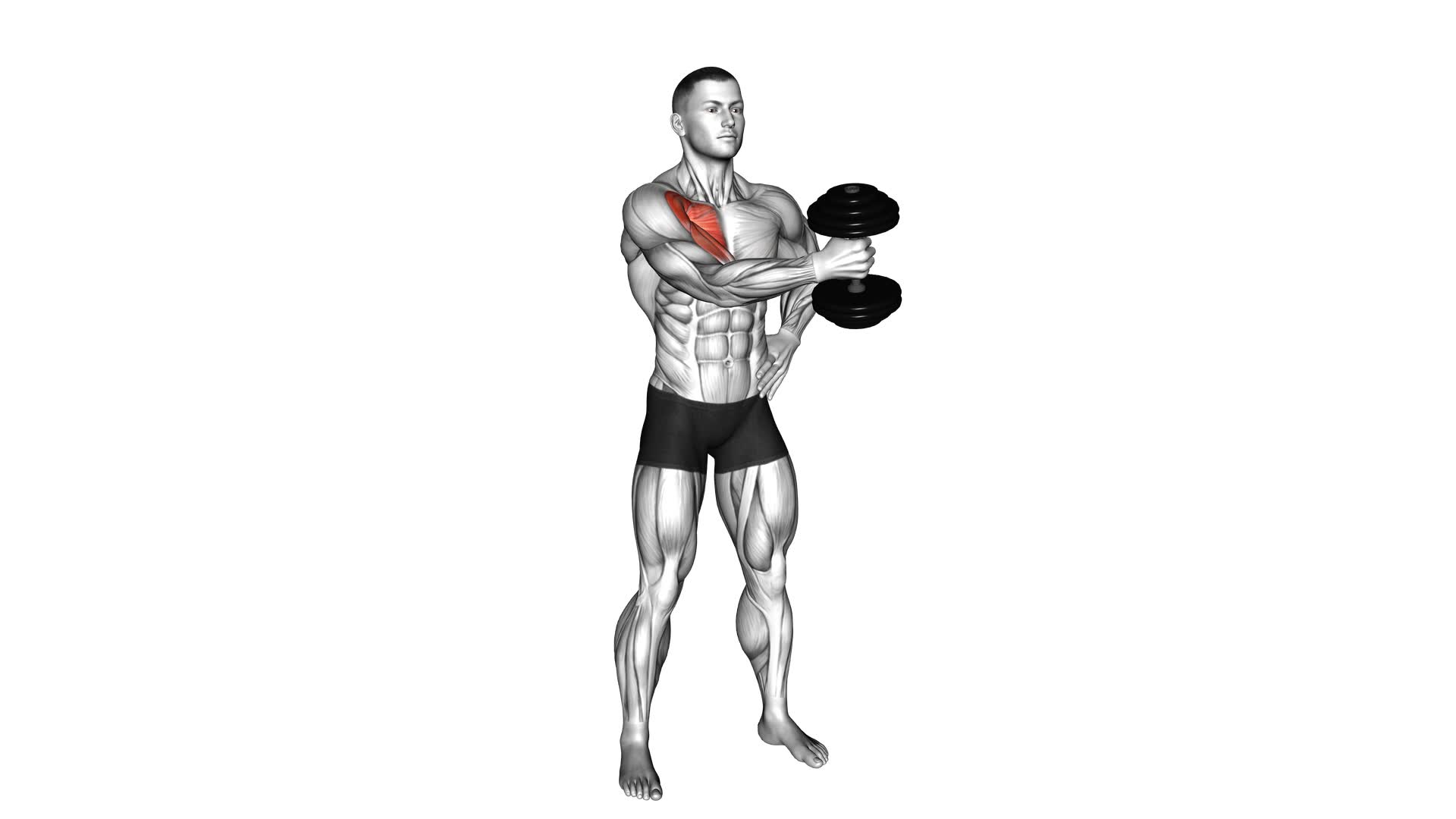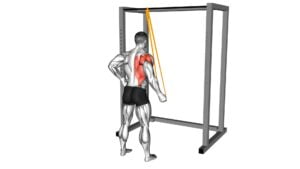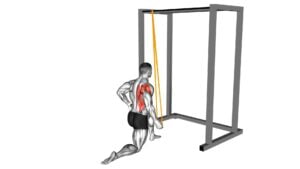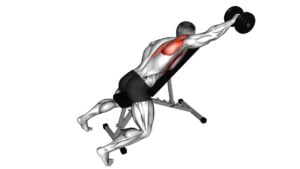Dumbbell Standing Single Arm Cross Raise – Video Exercise Guide & Tips

Looking to tone your shoulders and improve your upper body strength? The Dumbbell Standing Single Arm Cross Raise is a fantastic exercise to add to your routine. In this video exercise guide, we'll show you the proper form and technique for this movement, as well as provide helpful tips to maximize your shoulder workout.
Watch This Exercise Video
Whether you're a beginner or an experienced fitness enthusiast, this exercise is sure to challenge and strengthen your muscles. Let's get started!
Key Takeaways
- The dumbbell standing single arm cross raise improves shoulder strength and stability.
- Proper form and technique, such as keeping the elbow slightly bent and wrist straight, should be maintained during the exercise.
- Choosing the right weight is important, starting with a weight that can be comfortably lifted for 8-12 repetitions and gradually increasing as strength improves.
- Injury prevention can be prioritized by avoiding shoulder rotation, keeping the core engaged, and incorporating variations and progressions into the exercise routine.
Benefits of the Dumbbell Standing Single Arm Cross Raise
You will experience significant improvements in shoulder strength and stability when performing the Dumbbell Standing Single Arm Cross Raise. This exercise targets the deltoids, which are the muscles responsible for lifting and rotating the arms. By regularly incorporating this exercise into your workout routine, you can strengthen and stabilize your shoulder joints, reducing the risk of injury during daily activities and other exercises.
One of the main benefits of the Dumbbell Standing Single Arm Cross Raise is that it helps to isolate and strengthen the deltoids. This exercise specifically targets the medial deltoid, which is responsible for raising the arm sideways. By focusing on this muscle group, you can improve your overall shoulder strength and stability.
Additionally, the Dumbbell Standing Single Arm Cross Raise offers a variety of variations and progressions to keep your workouts challenging and exciting. You can increase the difficulty by using heavier dumbbells, incorporating a pause at the top of the movement, or performing the exercise on an unstable surface such as a Bosu ball.
In the subsequent section, we'll discuss the proper form and technique for performing the Dumbbell Standing Single Arm Cross Raise, ensuring that you maximize the benefits and avoid any potential injuries.
Proper Form and Technique for the Exercise
When performing the dumbbell standing single arm cross raise, it's important to pay attention to your arm position. Keep your elbow slightly bent and your wrist straight throughout the movement.
Additionally, maintaining core stability is crucial to prevent any excessive swinging or twisting.
Lastly, be aware of common form mistakes such as using momentum or lifting too heavy of a weight, as these can compromise the effectiveness and safety of the exercise.
Arm Position Tips
To achieve proper form and technique for the Dumbbell Standing Single Arm Cross Raise exercise, position your arm correctly. Here are some arm position tips to help you maximize your shoulder workout techniques:
- Keep your elbow slightly bent: Maintaining a slight bend in your elbow throughout the movement will help engage your shoulder muscles and prevent strain on your joints.
- Align your arm with your shoulder: Ensure that your arm is in line with your shoulder to target the correct muscles and avoid unnecessary stress on your joints.
- Control the movement: Slowly raise your arm across your body while maintaining control and stability. This will enhance the effectiveness of the exercise and reduce the risk of injury.
By following these arm position tips, you can perform the Dumbbell Standing Single Arm Cross Raise exercise with proper form and technique, improving your shoulder strength and stability.
Now, let's discuss the importance of core stability in this exercise.
Core Stability Importance
Maintaining core stability is crucial for performing the Dumbbell Standing Single Arm Cross Raise exercise with proper form and technique.
Core stability refers to the ability to maintain control and stability of the muscles in the torso, including the abdomen, back, and pelvis. By engaging and strengthening these muscles, you can improve your overall balance and stability during the exercise.
Core stability benefits not only your performance in this specific exercise but also in other daily activities and sports.
To enhance core stability, it's recommended to incorporate exercises such as planks, Russian twists, and bird dogs into your workout routine. These exercises target the muscles of the core and help improve your overall stability and balance.
Common Form Mistakes
To perform the Dumbbell Standing Single Arm Cross Raise exercise with proper form and technique, it's important to avoid common form mistakes. Here are three common mistakes to watch out for to prevent injury:
- Using too much weight: It can be tempting to lift heavy weights, but using too much weight can compromise your form and put unnecessary strain on your muscles and joints. Start with lighter weights and focus on proper technique before gradually increasing the weight.
- Rounding your shoulders: When performing the cross raise, it's important to keep your shoulders down and back, avoiding any rounding or hunching. This helps to engage the correct muscles and prevents strain on your neck and upper back.
- Swinging the dumbbell: To get the most out of this exercise, it's crucial to control the movement and avoid swinging the dumbbell. Swinging not only diminishes the effectiveness of the exercise but also increases the risk of injury. Focus on a controlled and smooth motion throughout the movement.
Choosing the Right Weight for Your Fitness Level
When choosing the right weight for your fitness level, it's important to consider your current strength and endurance. Weight selection plays a crucial role in ensuring that you perform exercises effectively and safely. If you choose a weight that's too heavy, you may compromise your form and increase the risk of injury. On the other hand, if you choose a weight that's too light, you may not challenge your muscles enough to see progress.
To determine the appropriate weight for your fitness level, start with a weight that you can comfortably lift for 8-12 repetitions without compromising your form. As you become stronger and more comfortable with the exercise, you can gradually increase the weight. It's important to listen to your body and make adjustments accordingly.
In addition to weight selection, modifying the exercise can also help you find the right level of challenge. If the exercise feels too easy, you can try increasing the range of motion, slowing down the tempo, or adding additional resistance, such as using a resistance band or performing the exercise on an unstable surface. On the other hand, if the exercise feels too difficult, you can modify it by using a lighter weight or performing a regression variation that targets the same muscle group.
Common Mistakes to Avoid
To ensure you perform the dumbbell standing single arm cross raise correctly and avoid potential injuries, it's important to be aware of common mistakes.
Incorrect form can put unnecessary strain on your muscles and joints, leading to discomfort or even injury.
Incorrect Form Dangers
One common mistake to avoid when performing the dumbbell standing single arm cross raise isn't maintaining proper alignment of your shoulder and elbow. This incorrect form can lead to various dangers and risks of improper technique.
Here are three potential consequences of not paying attention to your form:
- Shoulder strain: Allowing your shoulder to drop or rotate too much can put excessive stress on the joint and surrounding muscles, increasing the risk of strain or injury.
- Elbow discomfort: Failing to keep your elbow in line with your shoulder can result in discomfort or even pain in the elbow joint, especially when using heavy weights.
- Limited range of motion: Incorrect form can restrict the full range of motion of the exercise, reducing its effectiveness and potentially leading to muscle imbalances.
Preventing Injury Through Correction
To prevent injury and maximize your results, correct any common mistakes you may be making while performing the dumbbell standing single arm cross raise.
Injury prevention should always be a priority during any exercise routine. One common mistake to avoid is allowing your shoulder to rotate forward or backward during the movement. This can put unnecessary strain on the shoulder joint and increase the risk of injury. Instead, focus on keeping your shoulder blades pulled back and down throughout the exercise.
Another mistake to watch out for is using too much weight. Start with a lighter weight and gradually increase as you build strength and proper form.
Lastly, be mindful of your posture. Keep your core engaged and your spine neutral to avoid putting strain on your lower back.
Variations and Progressions to Challenge Yourself
Challenge yourself with different variations and progressions of the dumbbell standing single arm cross raise exercise. By incorporating these modifications into your workout routine, you can continue to challenge your muscles and achieve greater strength and definition.
Here are three variations to take your dumbbell standing single arm cross raise to the next level:
- Alternating Cross Raise: Instead of performing the exercise with one arm at a time, alternate between your left and right arms. This will increase the intensity and engage more muscles in your upper body.
- Double Arm Cross Raise: Hold a dumbbell in each hand and perform the cross raise simultaneously with both arms. This variation will challenge your coordination and require more strength and stability.
- Cross Raise with Pulse: After raising your arm across your body, pause at the top of the movement and perform a small pulse before lowering the weight. This will add an extra contraction to your muscles and increase the burn.
Incorporating these variations into your workout routine will keep your muscles guessing and prevent plateauing. Remember to start with lighter weights and gradually increase the resistance as you become more comfortable with each variation. Challenge yourself and reap the rewards of a stronger, more defined upper body.
Tips for Getting the Most Out of Your Shoulder Workout
To optimize your shoulder workout, focus on proper form and technique to target the muscles effectively. One important aspect of a shoulder workout is shoulder activation. This means engaging the shoulder muscles throughout the entire exercise to maximize their involvement and stimulate growth. To achieve this, it's crucial to maintain proper posture and alignment during each movement. Keep your shoulders back and down, and avoid shrugging or hunching forward.
Additionally, make sure to perform a thorough warm-up to increase blood flow to the muscles and prepare them for the workout.
Exercise modifications can also help you get the most out of your shoulder workout. If you find that certain exercises are too challenging or cause discomfort, don't hesitate to make adjustments. For example, if you struggle with overhead pressing movements, try using dumbbells instead of a barbell. This allows for a more natural range of motion and reduces strain on the shoulder joints. You can also vary the grip width or hand position to target different areas of the shoulders.
Experiment with different exercises and techniques to find what works best for you and your specific goals. Remember, it's important to listen to your body and make modifications as needed to prevent injury and ensure an effective workout.
Frequently Asked Questions
How Many Calories Can I Burn by Doing the Dumbbell Standing Single Arm Cross Raise?
You can burn calories by doing the dumbbell standing single arm cross raise. The exact number of calories burned will depend on factors such as your weight, intensity, and duration of the exercise.
To get a rough estimate, you can use a calorie calculator. However, it's important to note that this exercise may not be suitable for individuals with shoulder injuries.
It's always recommended to consult with a healthcare professional for modifications or alternative exercises.
Can I Perform This Exercise if I Have a Shoulder Injury?
If you have a shoulder injury, it's important to modify exercises to avoid further damage.
The Dumbbell Standing Single Arm Cross Raise may not be suitable for you in this case.
However, there are alternative exercises you can try that put less strain on the shoulders.
Consult with a healthcare professional or a qualified trainer who can provide you with specific modifications and alternative exercises to help you maintain your fitness routine safely.
Is It Necessary to Warm up Before Doing the Dumbbell Standing Single Arm Cross Raise?
It is important to warm up before any exercise to prevent injury and prepare your body for the workout. Warming up increases blood flow, loosens muscles, and improves flexibility.
For the dumbbell standing single arm cross raise, proper form and technique are crucial to maximize the benefits and minimize the risk of injury. Focus on maintaining a straight back, engaging your core, and keeping your arm straight as you raise the dumbbell across your body.
How Many Repetitions and Sets Should I Do for This Exercise?
For the dumbbell standing single arm cross raise exercise, you should aim for around 8 to 12 repetitions per set. This will help you build strength and muscle endurance.
As for sets, start with 2 to 3 sets and gradually increase as you become more comfortable and stronger.
Remember to listen to your body and adjust the repetitions and sets according to your fitness level and goals.
Can I Incorporate This Exercise Into a Full-Body Workout Routine?
Incorporating the dumbbell standing single arm cross raise into a full-body workout routine can be highly effective and provide a great upper body workout. It targets multiple muscle groups, including the shoulders, chest, and upper back.
By adding this exercise to your routine, you can enhance your overall strength and improve your posture. Remember to start with a weight that challenges you but allows you to maintain proper form.
Consider performing 3 sets of 10-12 repetitions on each arm for optimal results.
Conclusion
In conclusion, the Dumbbell Standing Single Arm Cross Raise is an effective exercise for targeting and strengthening the shoulders. By following proper form and technique, choosing the appropriate weight, and avoiding common mistakes, you can maximize the benefits of this exercise.
Additionally, by incorporating variations and progressions, you can challenge yourself and continue to improve your shoulder strength. Remember to always prioritize safety and listen to your body during your shoulder workouts.

Author
Years ago, the spark of my life’s passion ignited in my mind the moment I stepped into the local gym for the first time. The inaugural bead of perspiration, the initial endeavor, the very first surge of endorphins, and a sense of pride that washed over me post-workout marked the beginning of my deep-seated interest in strength sports, fitness, and sports nutrition. This very curiosity blossomed rapidly into a profound fascination, propelling me to earn a Master’s degree in Physical Education from the Academy of Physical Education in Krakow, followed by a Sports Manager diploma from the Jagiellonian University. My journey of growth led me to gain more specialized qualifications, such as being a certified personal trainer with a focus on sports dietetics, a lifeguard, and an instructor for wellness and corrective gymnastics. Theoretical knowledge paired seamlessly with practical experience, reinforcing my belief that the transformation of individuals under my guidance was also a reflection of my personal growth. This belief holds true even today. Each day, I strive to push the boundaries and explore new realms. These realms gently elevate me to greater heights. The unique combination of passion for my field and the continuous quest for growth fuels my drive to break new ground.







